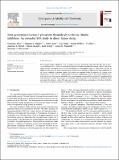Files in this item
Next generation glucose-1-phosphate thymidylyltransferase (RmlA) inhibitors : an extended SAR study to direct future design
Item metadata
| dc.contributor.author | Xiao, Ganyuan | |
| dc.contributor.author | Alphey, Magnus S. | |
| dc.contributor.author | Tran, Fanny | |
| dc.contributor.author | Pirrie, Lisa | |
| dc.contributor.author | Milbeo, Pierre | |
| dc.contributor.author | Zhou, Yi | |
| dc.contributor.author | Bickel, Jasmine K. | |
| dc.contributor.author | Kempf, Oxana | |
| dc.contributor.author | Kempf, Karl | |
| dc.contributor.author | Naismith, James H. | |
| dc.contributor.author | Westwood, Nicholas J. | |
| dc.date.accessioned | 2021-11-02T13:30:14Z | |
| dc.date.available | 2021-11-02T13:30:14Z | |
| dc.date.issued | 2021-11-15 | |
| dc.identifier | 276341100 | |
| dc.identifier | 03e290a3-dc87-4700-8d0f-c1a1dc5b33c1 | |
| dc.identifier | 85118334823 | |
| dc.identifier | 000719365900005 | |
| dc.identifier.citation | Xiao , G , Alphey , M S , Tran , F , Pirrie , L , Milbeo , P , Zhou , Y , Bickel , J K , Kempf , O , Kempf , K , Naismith , J H & Westwood , N J 2021 , ' Next generation glucose-1-phosphate thymidylyltransferase (RmlA) inhibitors : an extended SAR study to direct future design ' , Bioorganic & Medicinal Chemistry , vol. 50 , 116477 . https://doi.org/10.1016/j.bmc.2021.116477 | en |
| dc.identifier.issn | 0968-0896 | |
| dc.identifier.other | RIS: urn:0ECF94A60897114CED7371FCE73C41FA | |
| dc.identifier.other | ORCID: /0000-0003-0630-0138/work/101958309 | |
| dc.identifier.other | ORCID: /0000-0002-9353-3716/work/101958359 | |
| dc.identifier.uri | https://hdl.handle.net/10023/24244 | |
| dc.description | Funding: This work was supported by grants from The Scottish Universities Life Science Alliance (L.P., Ph.D. studentship), a China Scholarship Council-University of St Andrews PhD Fellowship (GX). JHN is funded by the Wellcome Trust (100209/Z/12/Z). | en |
| dc.description.abstract | The monosaccharide L-Rhamnose is an important component of bacterial cell walls. The first step in the L-rhamnose biosynthetic pathway is catalysed by glucose-1-phosphate thymidylyltransferase (RmlA), which condenses glucose-1-phosphate (Glu-1-P) with deoxythymidine triphosphate (dTTP) to yield dTDP-D-glucose. In addition to the active site where catalysis of this reaction occurs, RmlA has an allosteric site that is important for its function. Building on previous reports, SAR studies have explored further the allosteric site, leading to the identification of very potent P. aeruginosa RmlA inhibitors. Modification at the C6-NH2 of the inhibitor’s pyrimidinedione core structure was tolerated. X-ray crystallographic analysis of the complexes of P.aeruginosa RmlA with the novel analogues revealed that C6-aminoalkyl substituents can be used to position a modifiable amine just outside the allosteric pocket. This opens up the possibility of linking a siderophore to this class of inhibitor with the goal of enhancing bacterial cell wall permeability. | |
| dc.format.extent | 5547747 | |
| dc.language.iso | eng | |
| dc.relation.ispartof | Bioorganic & Medicinal Chemistry | en |
| dc.subject | Antibacterial drug discovery | en |
| dc.subject | Bacterial cell wall synthesis | en |
| dc.subject | RmlA | en |
| dc.subject | Structure-based optimization | en |
| dc.subject | QR Microbiology | en |
| dc.subject | NDAS | en |
| dc.subject.lcc | QR | en |
| dc.title | Next generation glucose-1-phosphate thymidylyltransferase (RmlA) inhibitors : an extended SAR study to direct future design | en |
| dc.type | Journal article | en |
| dc.contributor.sponsor | The Wellcome Trust | en |
| dc.contributor.institution | University of St Andrews. School of Chemistry | en |
| dc.contributor.institution | University of St Andrews. School of Biology | en |
| dc.contributor.institution | University of St Andrews. Biomedical Sciences Research Complex | en |
| dc.contributor.institution | University of St Andrews. EaSTCHEM | en |
| dc.identifier.doi | 10.1016/j.bmc.2021.116477 | |
| dc.description.status | Peer reviewed | en |
| dc.identifier.grantnumber | 100209/Z/12/Z | en |
This item appears in the following Collection(s)
Items in the St Andrews Research Repository are protected by copyright, with all rights reserved, unless otherwise indicated.

